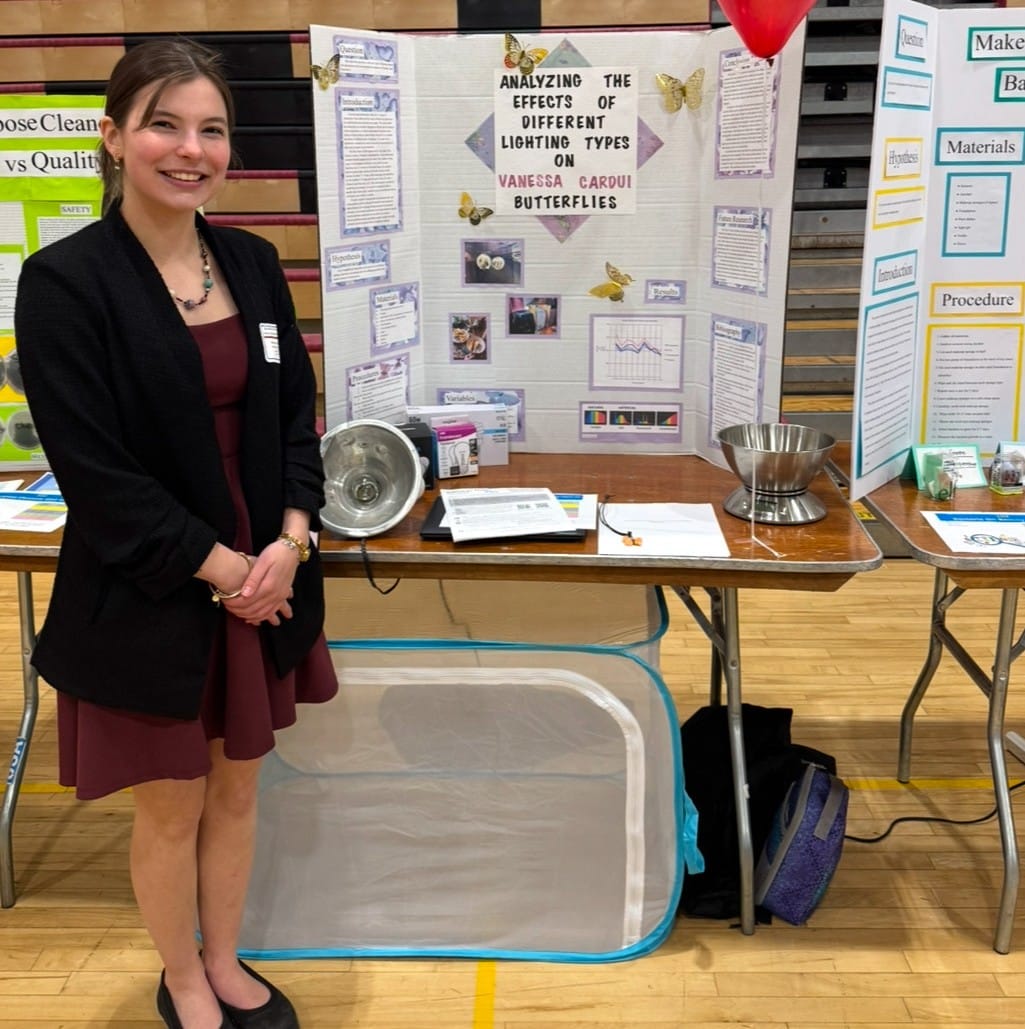WHS junior Kaitlynn Goulette received first place for “Analyzing the Effects of Different Lighting Types on Vanessa cardui Butterflies.”
Reminder Publishing submitted photo
WESTFIELD — People are still talking about the Science and Engineering Fair hosted in the Westfield High School gym on Jan. 30. It was hard to not be impressed by the enthusiasm of the future scientist, engineers and artists displaying projects and theses they had spent weeks and months and sometimes several years developing. A total of 214 students participated, 66 from Westfield Technical Academy.
WHS Principal Charles Jendrysik said he was very happy to see the number of students from WTA participating in the Science Fair this year alongside WHS students. He said he also loves seeing students build on their projects from previous years. “It’s great to see the students excited about learning,” Jendrysik said.
First place at the Science Fair went to junior Kaitlynn Goulette for her project “Analyzing the Effects of Different Lighting Types on Vanessa cardui Butterflies.”
Goulette said the idea for the project began back when she first got into astronomy and got her first telescope at 5 years old. She and her father looked at all the stars in the sky, and realized there was a “ton of light pollution.” They bought sodium lighting filters to block the street lamps, which she said helped, explaining that stars in the sky shine on a different wavelength.
Two months later, Goulette said the entire city changed to LED lights, and the filter no longer worked. “From then on it was a struggle, and it has been,” she said.
Working at the Seymour Planetarium as an instructor this past summer, Goulette realized that light pollution also has an impact on human bodies, impacting their circadian rhythms or 24-hour internal clock, and she decided for this year’s project she wanted to study the physical impacts of light.
“I bought a bunch of butterflies and raised them from larvae. Once they formed chrysalises, I put them in four different cages and fed them every two days, to measure their consumption rates,” Goulette said. She said she prepared crushed bananas, which she froze and changed out every two days, and used a decimal scale she purchased to weigh the butterflies.
Goulette used different lighting on each cage. One had LED lights, which she called “the worst spectrum, very heavily in blue.” She said the cage with fluorescent lighting was also the worst, or most unnatural lighting, and very spiky.
She said the cage with incandescent light, which was most similar to natural light with minimal blue and heavy in the red spectrum that the butterflies prefer, did the best. The cage with natural sunlight from her window didn’t do as well as she expected. She said by not using a lightbulb and relying on the sun which moves around and is low in the sky October to December, messed up her data.
Goulette said if she were to continue the project next year, she would love to experiment with lightbulbs that mimic natural lighting and also infrared lighting, taking the butterflies’ preference for the red spectrum even further. She hasn’t decided yet if she will continue this project.
This was the second year on the butterfly project. Last year, Goulette experimented with reproduction rates based on LED lighting only, changing the length of time the butterflies were exposed, but It was not very successful, she said, and none of the butterflies reproduced.
Goulette, who is interested in pursuing studies in astronomy and astrophysics and is president of the WHS Astronomy Club, will now be among 17 finalists from the Science and Engineering Fair who will participate in the regional fair at Western New England University on March 7. Her project last year won a WG&E Power Plus award and a second place for “The Effects of LED Lighting on Painted Lady Butterflies.”
The complete list of finalists who have been invited to attend the regional fair at WNEU include:
- First place — Kaitlynn Goulette (WHS) — “Analyzing the Effects of Different Lighting Types on Vanessa cardui Butterflies”
- Second Place — Brandon Guyott and Justin Romanelli (WHS) — “Optimizing an After-Market Prototype That Operates a Window Remotely”
- Third Place — Giovanni Santaniello (WHS) — “The Solar Umbrella”
Other top finishers invited to the regional fair in alphabetical order are:
- Luke Bulan and Emily Bulan (WHS) — “Designing an Economical Multi-Purpose Care Blanket for Neonates — Part III”
- Isabella Chalmers (WHS) — “Testing Melatonin’s Effectiveness on Anti-Aging Through Plants”
- Teagan Chisholm-Godshalk (WHS) — “Skin Deep: Investigating How Product Knowledge and Social Media Influences Decision-Making”
- Liz Coach and Hannah Callini (WHS) — “How Different Hand Soaps Affect Bacterial Growth”
- Sydney Drugan (WHS) — “Finding the Best Material for a Volcanic Ash Field Cover”
- Makayla Ellis and Andy Liu (WHS) — “Slipper Shells for Slippery Slopes”
- Clara Hubbard (WHS) — “Unmasking the Data: Evaluating the Effectiveness of Different Materials in Preventing Bacterial Growth”
- Scarlet Karwoski (WHS) — “The Impact of Varied Environmental Temperature on Neocaridina davidi Reproduction Rate”
- Wyatt Lee and Carson Mayer (WTA) — “Two -Way Communication Link in Sub-GHz Band”
- Zach Maslar and Alec Piepergerdes (WHS) — “Does Artificial Grass Infill Release Heavy Metals?”
- Ben Miller (WHS) — “Road to Less Congestion”
- Meagan Nubile (WHS) — “Can Beeswax Wraps be an Alternative to Plastic Wraps?”
- Gabriella Scottoni and Matt Rothus (WTA) — “Making it Accessible – Scientific Hand Models”
- Makenzie Watt and Abby Jemiolo (WHS) — “Comparative Analysis of Sunscreen SPF Ratings and UV Protection.”


